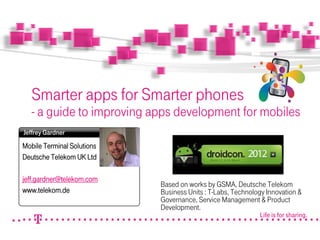Smarter Apps for Smarter phones - see me at bit.ly/1ezHj0c
- 1. Life is for sharing. Smarter apps for Smarter phones - a guide to improving apps development for mobiles Mobile Terminal Solutions Deutsche Telekom UK Ltd jeff.gardner@telekom.com www.telekom.de Jeffrey Gardner Photo (s. Tipp rechts Based on works by GSMA, Deutsche Telekom Business Units : T-Labs, Technology Innovation & Governance, Service Management & Product Development.
- 2. 2 This presentation covers the following… How Mobile Operators view smart phones & apps The objectives of the apps developer guidelines Working examples of the apps guidelines Where you can find and contribute to the guidelines GSMA sponsored – smarter apps challenge
- 3. 3 Chronicle of the Smartphone and consumer usage 2000 2002 2003 2004 2007 2009 2010 2011 GPRS/ WAP 1.0 MMS iPhone Windows Phone 7 WAP 2.0 UMTS Android LTE 0 1 2 3 4 5 6 2006 2008 2010 2012 User Data consumption High Medium Low User Data consumption High Medium Low
- 4. 4 How Smartphone apps impact mobile networks Smartphone users Network Operator apps Service providers Apps ‘chattiness’ overloads Operators signalling network
- 5. 5 How Smartphone apps impact mobile users source: T-Mobile US analysis for G1, defined user activity (power user) and two different Instant Messaging applications as on top activity in comparison Apps ‘chattiness’ consumes battery life Traffic Pattern 33% 73% 100% G1 with heartbeat: every 28 minutes IM App A reload: every 4 minutes IM App B reload: every 1 minutes Battery LifetimeApps activity (chat)
- 6. 6 Smartphone Challenge - eco system approach Apps Networks Terminals AppsOS TerminalsNetworks OS Collaborate with OS suppliers to optimize efficiency Drive mitigating features through 3GPP Ensure integration into terminal specification Optimize network configuration Drive resource friendly features within network releases Execute granular load monitoring Analyze Apps and address critical behavior Drive harmonized developer guidelines through GSMA
- 7. 7 Mobile Network ‘Know-How’ for 3rd party developers Objective: The “developer guidelines” document aims to create awareness amongst new/novice developers while encouraging better development habits. Provides a set of key principles (some independent of the underlying platform) covering:- Asynchrony Connection Loss and Error Handling Caching Efficient Traffic Usage Compression Background/Foreground Modes Security Scope : Targeted at Android, Windows Mobile & iOS
- 8. 8 Developer Guidelines – what areas are addressed? Connection Loss + Error Handling Asynchrony Latency Non-Modal User Interface Connectivity User Experience Compression Fast Dormancy HTTP Cache Data Formats Network Efficiency Security Media Transcoding Local Cache Application Scaling Optimizing Network Requests User experience Mobile connection Device battery
- 9. 9 Asynchrony Connection Loss + Error Handling Latency Non-Modal User Interface Connectivity User Experience Asynchrony Connection Loss + Error Handling Latency Non-Modal User Interface Connectivity User Experience Connectivity User Experience Topic : Asynchrony 9 Mobile networks are relatively slow Synchronous requests Asynchronous requests (ideal) Asynchronous requests (real mobile network) Image 1 Image 2 Image 3 (no response)
- 10. 1010 Network activities should be visible to the end user Connectivity User Experience Topic : Non Modal User Interface User interface should not be blocking Non Modal User Interface Connection Loss + Error Handling Aynchrony Latency Connectivity User Experience Non Modal User Interface Connection Loss + Error Handling Aynchrony Latency Connectivity User Experience
- 11. 11 Fast Dormancy HTTP Cache Compression Data Formats Security Network Efficiency Fast Dormancy HTTP Cache Compression Data Formats Security Network Efficiency 11 Awareness of how networks save battery & signalling Power Datatransfer Before Network efficiency Topic : Fast dormancy After Power Time Datatransfer Data transfer =90kb Power used = x Time = y Data transfer =90kb Power used = x/3 Time = y/3 } } 30Kb 30Kb 90Kb 30Kb
- 12. 12 And now for the video ! See it @ www.gsma.com/smarterapp Shortcut to 120227_SmarterApp_FINAL_V2.wmv.lnk
- 13. 13 To download, feedback and engage go to… Download the full document @ www.gsma.com/smarterapp You can provide feedback on the document by emailing devguide@gsm.org You can join the dedicated W3C community discussion at www.w3.org/community/networkfriendly/join You can enter a competition, prove your app as being network efficient, and win prize money and a trip to Asia World Congress www.mobileappchallenge.com/smarterapp Tweet @appchallenge 13 It‘s free It‘s free
- 14. 14 Acknowledgements The guideline has been compiled by operators, vendors and developers. It is a living document and planned to be updated on regular basis. All trademarks are acknowledged. 1 iOS is a trademark or registered trademark of Cisco in the U.S. and other countries and is used under licence by Apple Inc. www.apple.com 2 Mac® and Mac OS® are trademarks of Apple Inc., registered in the U.S. and other countries. 3 Android™ is a trademark of Google Inc. in the U.S. and other countries. www.android.com 4 Windows® is a registered trademark of Microsoft Corporation in the United States and other countries. www.microsoft.com GSMA is a registered trademark of GSMA Ltd. in the United Kingdom and other countries. Copyright Notice Copyright © 2012 GSM Association. 14
- 15. 15

